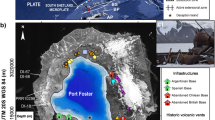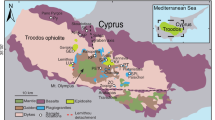Abstract
The abundance of volatile compounds, and particularly CO2, in the upper oceanic mantle affects the style of volcanic eruptions. At mid-ocean ridges, eruptions are generally dominated by the gentle effusion of basaltic lavas with a low volatile content. However explosive volcanism has been documented at some ocean spreading centres1,2,3, indicative of abundant volatile compounds. Estimates of the initial CO2 concentration of primary magmas can be used to constrain the CO2 content of the upper oceanic mantle, but these estimates vary greatly4,5. Here we present ion microprobe measurements of the CO2 content of basaltic melt trapped in plagioclase crystals. The crystals are derived from volcanic ash deposits erupted explosively at Axial Seamount, Juan de Fuca Ridge, in the northeast Pacific Ocean. We report unusually high CO2 concentrations of up to 9,160 ppm, which indicate that the upper oceanic mantle is more enriched in carbon than previously thought. We furthermore suggest that CO2 fluxes along mid-ocean ridges4,5 vary significantly. Our results demonstrate that elevated fluxes of CO2 from the upper oceanic mantle can drive explosive eruptions at mid-ocean ridges.
This is a preview of subscription content, access via your institution
Access options
Subscribe to this journal
Receive 12 print issues and online access
$259.00 per year
only $21.58 per issue
Buy this article
- Purchase on Springer Link
- Instant access to full article PDF
Prices may be subject to local taxes which are calculated during checkout



Similar content being viewed by others
References
Clague, D. A., Davis, A. S. & Dixon, J. E. in Explosive Subaqueous Volcanism (eds White, J. D. L. & Clague, Smellie) (American Geophysical Union, 2003).
Clague, D. A., Paduan, J. B. & Davis, A. S. Widespread strombolian eruptions of mid-ocean ridge basalt. J. Volcanol. Geotherm. Res. 180, 171–188 (2009).
Sohn, R. A. et al. Explosive volcanism on the ultraslow-spreading Gakkel ridge, Arctic Ocean. Nature 453, 1236–1238 (2008).
Saal, A. E., Hauri, E. H., Langmuir, C. H. & Perfit, M. R. Vapour undersaturation in primitive mid-ocean-ridge basalt and the volatile content of Earth’s upper mantle. Nature 419, 451–455 (2002).
Cartigny, P., Pineau, F., Aubaud, C. & Javoy, M. Towards a consistent mantle carbon flux estimate: Insights from volatile systematics (H2O/Ce, δD, CO2/Nb) in the North Atlantic mantle (14° N and 34° N). Earth Planet. Sci. Lett. 265, 672–685 (2008).
Davis, A. S. & Clague, D. A. in Explosive Subaqueous Volcanism (eds White, J. D. L., Smellie, J. L. & Clague, D. A.) (American Geophysical Union, 2003).
Clague, D. A., Davis, A. S., Bischoff, J. L., Dixon, J. E. & Geyer, R. Lava bubble-wall fragments formed by submarine hydrovolcanic: Explosions on Lo’ihi Seamount and Kilauea Volcano. Bull. Volcanol. 61, 437–449 (2000).
Maicher, D. & White, J. D. L. The formation of deep-sea Limu o Pele. Bull. Volcanol. 63, 482–496 (2001).
Dixon, J. E. & Stolper, E. M. An experimental study of water and carbon dioxide solubilities in mid-ocean ridge basaltic liquids. 2. Applications to degassing. J. Petrol. 36, 1633–1646 (1995).
Javoy, M. & Pineau, F. The volatiles record of a ‘popping rock’ from the Mid-Atlantic Ridge at 14° N: Chemical and isotopic composition of gas trapped in the vesicles. Earth Planet. Sci. Lett. 107, 598–611 (1991).
West, M., Menke, W., Tolstoy, M., Webb, S. & Sohn, R. Magma storage beneath Axial volcano on the Juan de Fuca mid-ocean ridge. Nature 413, 833–836 (2001).
PetDB. Petrological Database of the Ocean Floor, http://www.petdb.org.
Newman, S. & Lowenstern, J. B. VOLATILECALC: A silicate melt-H2O–CO2 solution model written in Visual Basic for Excel. Comput. Geosci. 28, 597–604 (2002).
Gerlach, T. M. Comment on ‘Mid-ocean ridge popping rocks: Implications for degassing at ridge crests’ by P. Sarda and D. Graham. Earth Planet. Sci. Lett. 105, 566–567 (1991).
Hekinian, R. et al. Deep sea explosive activity on the Mid-Atlantic Ridge near 34°50′ N: Magma composition, vesicularity and volatile content. J. Volcanol. Geotherm. Res. 98, 49–77 (2000).
Shaw, A. M., Behn, M. D., Humphris, S. E., Sohn, R. A. & Gregg, P. M. Deep pooling of low degree melts and volatile fluxes at the 85° E segment of the Gakkel Ridge: Evidence from olivine-hosted melt inclusions and glasses. Earth Planet. Sci. Lett. 289, 311–322 (2010).
Gilbert, L. A., McDuff, R. E. & Johnson, H. P. Porosity of the upper edifice of Axial Seamount. Geology 35, 49–52 (2007).
Grove, L. T., Kinzler, R. J. & Bryan, W. B. in Mantle Flow and Melt Generation at Mid-Ocean Ridges (eds Morgan, J. P., Blackman, D. K. & Sinton, J. M.) (American Geophysical Union, 1992).
Nielsen, R. L. et al. Melt inclusions in high-An plagioclase from the Gorda Ridge: An example of the local diversity of MORB parent magmas. Contrib. Mineral. Petrol. 122, 34–50 (1995).
Bottinga, Y. & Javoy, M. Midocean ridge basalt degassing—bubble nucleation. J. Geophys. Res. 95, 5125–5131 (1990).
Head, J. W. & Wilson, L. Deep submarine pyroclastic eruptions: Theory and predicted landforms and deposits. J. Volcanol. Geotherm. Res. 121, 155–193 (2003).
Jaupart, C. & Vergniolle, S. The generation and collapse of foam layer at the roof of a basaltic magma chamber. J. Fluid. Mech. 203, 347–380 (1989).
Hofmann, A. W. Chemical differentiation of the earth—the relationship between mantle, continental crust, and oceanic crust. Earth Planet. Sci. Lett. 90, 297–314 (1988).
West, M., Menke, W. & Tolstoy, M. Focused magma supply at the intersection of the Cobb hotspot and the Juan de Fuca ridge. Geophys. Res. Lett. 30, 1724 (2003).
Cogné, J. P. & Humler, E. Trends and rhythms in global seafloor generation rate. Geochem. Geophys. Geosyst. 7, Q03011 (2006).
Shimizu, K. et al. CO2-rich komatiitic melt inclusions in Cr-spinels within beach sand from Gorgona Island, Colombia. Earth Planet. Sci. Lett. 288, 33–43 (2009).
Dixon, J. E. & Clague, D. A. Volatiles in basaltic glasses from Loihi Seamount, Hawaii: Evidence for a relatively dry plume component. J. Petrol. 42, 627–654 (2001).
Hauri, E. et al. SIMS analysis of volatiles in silicate glasses 1. Calibration, matrix effects and comparisons with FTIR. Chem. Geol. 183, 99–114 (2002).
Fine, G. & Stolper, E. Dissolved carbon dioxide in basaltic glasses: Concentrations and speciation. Earth Planet. Sci. Lett. 76, 263–278 (1986).
Shimizu, N. & Hart, S. R. Applications of the ion-micro-probe to geochemistry and cosmochemistry. Annu. Rev. Earth Planet. Sci. 10, 483–526 (1982).
Acknowledgements
The authors thank the Captain and crew of the RV Western Flyer and the pilots of the ROV Tiburon for their support and expertise during the 2006 MBARI Vance Expedition. The expedition and D.A.C. were supported through a grant to MBARI from the David and Lucile Packard Foundation. C.H. was supported by R. H. Tomlinson, GEOTOP and J. W. McConnell Memorial Fellowships at McGill University. J.S. was supported by grants from the Natural Sciences and Engineering Research Council of Canada. We thank B. Watson from the Rensselaer Polytechnic Institute for synthesising the high-CO2 glass standard NS-1, and C. Mandeville from the American Museum of Natural History for the FTIR determination of CO2 content of this standard.
Author information
Authors and Affiliations
Contributions
C.H. performed volatile analysis and major element analysis of the melt inclusions and host glasses, and analysed the data. M-A.L. performed the trace element analysis of the melt inclusions, N.S. supervised the volatile and trace element analysis, D.A.C. was responsible for the organization of the cruise and sample collection, and J.S. supervised the work. The manuscript was written primarily by C.H., with contributions from M-A.L., N.S., D.A.C. and J.S.
Corresponding author
Ethics declarations
Competing interests
The authors declare no competing financial interests.
Supplementary information
Supplementary Information
Supplementary Information (PDF 1045 kb)
Rights and permissions
About this article
Cite this article
Helo, C., Longpré, MA., Shimizu, N. et al. Explosive eruptions at mid-ocean ridges driven by CO2-rich magmas. Nature Geosci 4, 260–263 (2011). https://doi.org/10.1038/ngeo1104
Received:
Accepted:
Published:
Issue Date:
DOI: https://doi.org/10.1038/ngeo1104
This article is cited by
-
Role of volatiles in highly explosive basaltic eruptions
Communications Earth & Environment (2022)
-
Dynamics of deep-submarine volcanic eruptions
Scientific Reports (2022)
-
Rapid heat discharge during deep-sea eruptions generates megaplumes and disperses tephra
Nature Communications (2021)
-
Persistent gas emission originating from a deep basaltic magma reservoir of an active volcano: the case of Aso volcano, Japan
Contributions to Mineralogy and Petrology (2021)
-
Deep sea explosive eruptions may be not so different from subaerial eruptions
Scientific Reports (2020)



